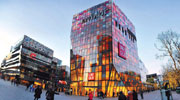
Before the existence of department stores in China, people bought different things in different shops.
For example, they go to grocery stores for food, visit a tailor for clothes, and engage carpenters to custom-make furniture. Some big towns even had streets that specialized in certain items.
Nanjing Road in Shanghai is probably the most well-known shopping street in China, which can be traced back to 1845 when it was called Park Lane. At the beginning of the 20th century, eight big department stores and a series of franchised stores stood along the street. It became the shopping center of the Far East.
On Oct 20, 1917, Sincere, the first department store built by Chinese investors, opened on Nanjing Road.
After the founding of the People's Republic of China in 1949, the growth of department stores stopped because of the country's planned economy.
When the reform and opening up policy was introduced in the late 1970s, Chinese department stores began to sprout again and since then, have been mushrooming.
During the 1980s and 1990s, they played a very important role in daily life. Some of them became the landmarks of major cities, for example, Beijing's Wangfujing Department Store.
Mega shopping malls appeared following the boom of the country's economy. It was introduced in the mid-1990s by those who had studied abroad, and as more foreign enterprises began to invest in the country.
|
 |
 Chilly feelings toward thermals are thawing |
